engine RENAULT KOLEOS 2012 1.G Owner's Manual
[x] Cancel search | Manufacturer: RENAULT, Model Year: 2012, Model line: KOLEOS, Model: RENAULT KOLEOS 2012 1.GPages: 233, PDF Size: 7.81 MB
Page 66 of 233
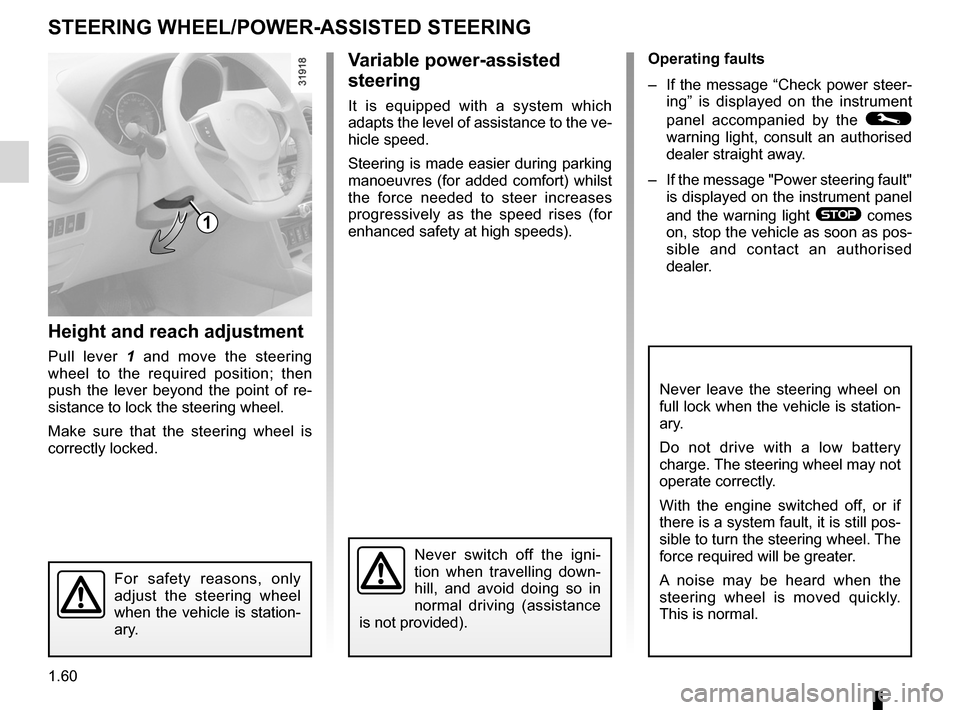
steering wheeladjustment ...................................... (up to the end of the DU)
power-assisted steering ........................(up to the end of the DU)
power-assisted steering ........................(up to the end of the DU)
1.60
ENG_UD27278_4
Volant de direction/Direction assist e (X45 - H45 - Renault)
ENG_NU_977-2_H45_Ph2_Renault_1
Operating faults
–
If the message “Check power steer-
ing ” is displayed on the instrument
panel accompanied by the
©
warning light, consult an authorised
dealer straight away.
–
If the message "Power steering fault"
is displayed on the instrument panel
and the warning light
® comes
on, stop the vehicle as soon as pos-
sible and contact an authorised
dealer.
Steering wheel
Power-assisted steering
sTEERINg WhEEL/pOWER-AssIsTEd sTEERINg
height and reach adjustment
Pull lever 1 and move the steering
wheel to the required position; then
push the lever beyond the point of re -
sistance to lock the steering wheel.
Make sure that the steering wheel is
correctly locked.
For safety reasons, only
adjust the steering wheel
when the vehicle is station-
ary.
Never switch off the igni -
tion when travelling down -
hill, and avoid doing so in
normal driving (assistance
is not provided).
1
v ariable power-assisted
steering
It is equipped with a system which
adapts the level of assistance to the ve-
hicle speed.
Steering is made easier during parking
manoeuvres (for added comfort) whilst
the force needed to steer increases
progressively as the speed rises (for
enhanced safety at high speeds).
Never leave the steering wheel on
full lock when the vehicle is station-
ary.
Do not drive with a low battery
charge. The steering wheel may not
operate correctly.
With the engine switched off, or if
there is a system fault, it is still pos-
sible to turn the steering wheel. The
force required will be greater.
A noise may be heard when the
steering wheel is moved quickly.
This is normal.
Page 67 of 233
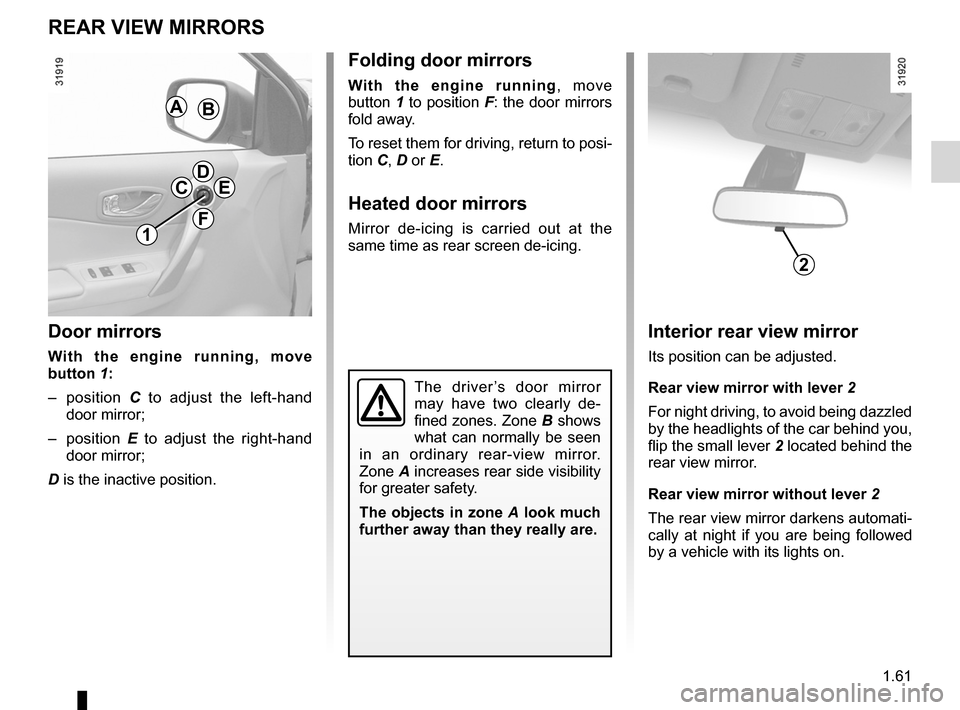
rear view mirrors ................................... (up to the end of the DU)
1.61
ENG_UD7744_2
Rétroviseurs (X45 - H45 - Renault)
ENG_NU_977-2_H45_Ph2_Renault_1
Rear-view mirrors
REAR vIEW MIRRORs
door mirrors
With the engine running, move
button 1:
– position C to adjust the left-hand
door mirror;
– position E to adjust the right-hand
door mirror;
D is the inactive position.
folding door mirrors
With the engine running , move
button 1 to position F: the door mirrors
fold away.
To reset them for driving, return to posi-
tion C, D or E.
heated door mirrors
Mirror de-icing is carried out at the
same time as rear screen de-icing.
The driver ’s door mirror
may have two clearly de -
fined zones. Zone B shows
what can normally be seen
in an ordinary rear-view mirror.
Zone A increases rear side visibility
for greater safety.
The objects in zone A look much
further away than they really are.
1
cdE
f
AB
Interior rear view mirror
Its position can be adjusted.
Rear view mirror with lever 2
For night driving, to avoid being dazzled
by the headlights of the car behind you,
flip the small lever 2 located behind the
rear view mirror.
Rear view mirror without lever 2
The rear view mirror darkens automati-
cally at night if you are being followed
by a vehicle with its lights on.
2
Page 69 of 233

lighting:exterior ............................................ (up to the end of the DU)
instrument panel ................................... (up to the end of the DU)
lights: side lights ........................................ (up to the end of the DU)
lights: dipped beam headlights .................. (up to the end of the DU)
hazard warning lights signal ................. (up to the end of the DU)
signals and lights .................................. (up to the end of the DU)
lighting: instrument panel ............................. (up to the end of the DU)
1.63
ENG_UD23490_3
Eclairages et signalisations extérieures (X45 - H45 - Renault)
ENG_NU_977-2_H45_Ph2_Renault_1
Exterior lighting and signals
EXTERIOR LIghTINg ANd sIgNALs (1/3)
kdipped beam
headlights
Manual operation
Turn the ring 3 until the symbol is oppo -
site mark 2 . This indicator light on the
instrument panel comes on.
Automatic operation
(depending on vehicle)
Turn ring 3 until the AUTO symbol is op-
posite mark 2: with the engine running,
the dipped beam headlights switch on
or off automatically depending on the
brightness of the light outside, without
any action on stalk 1.
šside lightsTurn the ring 3 until the symbol
is opposite mark 2.
The instrument panel will light up. The
brightness can be adjusted by turning
the control knob 4. If the side lights are
not switched on, it is not possible to set
the brightness. This control can also
be used to adjust the brightness of the
audio equipment and air conditioning
display.
áMain beam headlightsWith the dipped beam head -
lights lit, push stalk 1 forwards. This
indicator light on the instrument panel
comes on.
To return to the dipped headlight posi-
tion, pull the stalk 1 towards you again.
If the headlights are off, you can pull
stalk 1 towards you to flash the head -
lights. The headlights go off as soon as
the stalk is released.
Before driving at night:
check the electrical equip -
ment is operating correctly
and adjust your headlights
(if your vehicle is not carrying its
normal load). As a general precau -
tion, check that the lights are not
obscured (by dirt, mud, snow or ob-
jects being transported).
1
432
1
Page 70 of 233
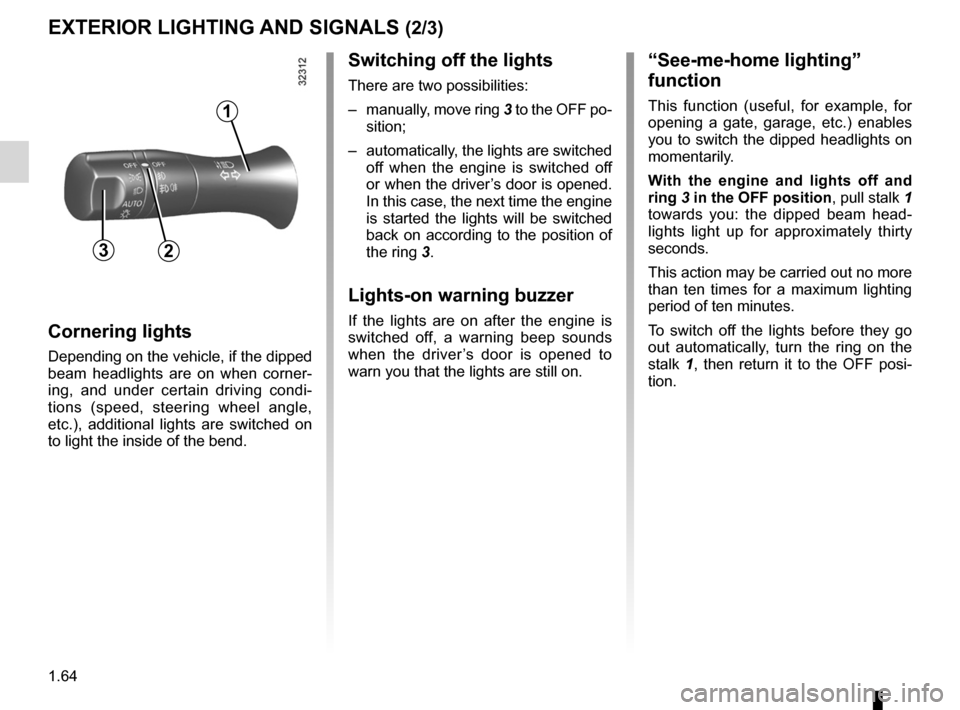
lightsmobile directional ............................................. (current page)
see-me-home lighting ............................................ (current page)
lights-on warning buzzer ........................................ (current page)
1.64
ENG_UD23490_3
Eclairages et signalisations extérieures (X45 - H45 - Renault)
ENG_NU_977-2_H45_Ph2_Renault_1
Jaune NoirNoir texte
EXTERIOR LIghTINg ANd sIgNALs (2/3)
cornering lights
Depending on the vehicle, if the dipped
beam headlights are on when corner -
ing, and under certain driving condi -
tions (speed, steering wheel angle,
etc.), additional lights are switched on
to light the inside of the bend.
switching off the lights
There are two possibilities:
– manually, move ring 3 to the OFF po-
sition;
– automatically, the lights are switched
off when the engine is switched off
or when the driver’s door is opened.
In this case, the next time the engine
is started the lights will be switched
back on according to the position of
the ring 3.
Lights-on warning buzzer
If the lights are on after the engine is
switched off, a warning beep sounds
when the driver ’s door is opened to
warn you that the lights are still on.
“see-me-home lighting”
function
This function (useful, for example, for
opening a gate, garage, etc.) enables
you to switch the dipped headlights on
momentarily.
With the engine and lights off and
ring 3 in the Off position , pull stalk 1
towards you: the dipped beam head -
lights light up for approximately thirty
seconds.
This action may be carried out no more
than ten times for a maximum lighting
period of ten minutes.
To switch off the lights before they go
out automatically, turn the ring on the
stalk 1 , then return it to the OFF posi -
tion.
32
1
Page 73 of 233
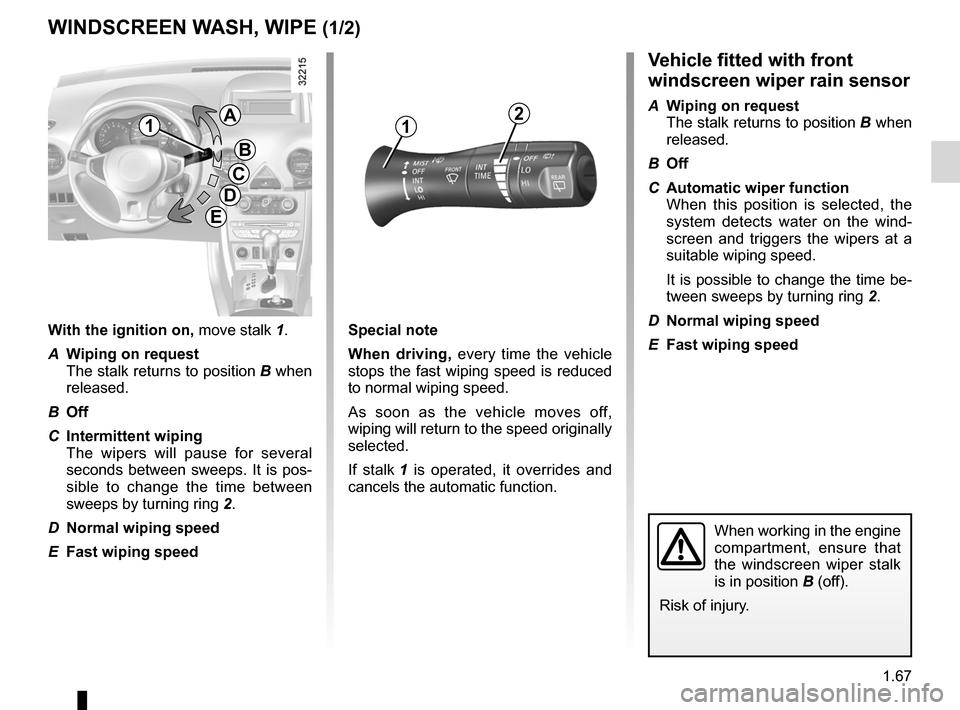
screen wash/wipe ................................. (up to the end of the DU)
windscreen washer ............................... (up to the end of the DU)
1.67
ENG_UD27146_5
Essuie-vitre, lave-vitre avant (X45 - H45 - Renault)
ENG_NU_977-2_H45_Ph2_Renault_1
Front windscreen wash/wiper
WINdscREEN WAsh, WIpE (1/2)
With the ignition on, move stalk 1.
A Wiping on request
The stalk returns to position B when
released.
B Off
C Intermittent wiping
The wipers will pause for several
seconds between sweeps. It is pos-
sible to change the time between
sweeps by turning ring 2.
D Normal wiping speed
E fast wiping speedspecial note
When driving, every time the vehicle
stops the fast wiping speed is reduced
to normal wiping speed.
As soon as the vehicle moves off,
wiping will return to the speed originally
selected.
If stalk 1 is operated, it overrides and
cancels the automatic function.
v ehicle fitted with front
windscreen wiper rain sensor
A Wiping on request
The stalk returns to position B when
released.
B Off
C Automatic wiper function
When this position is selected, the
system detects water on the wind -
screen and triggers the wipers at a
suitable wiping speed.
It is possible to change the time be-
tween sweeps by turning ring 2.
D Normal wiping speed
E fast wiping speed
When working in the engine
compartment, ensure that
the windscreen wiper stalk
is in position B (off).
Risk of injury.
121A
B
c
d
E
Page 76 of 233
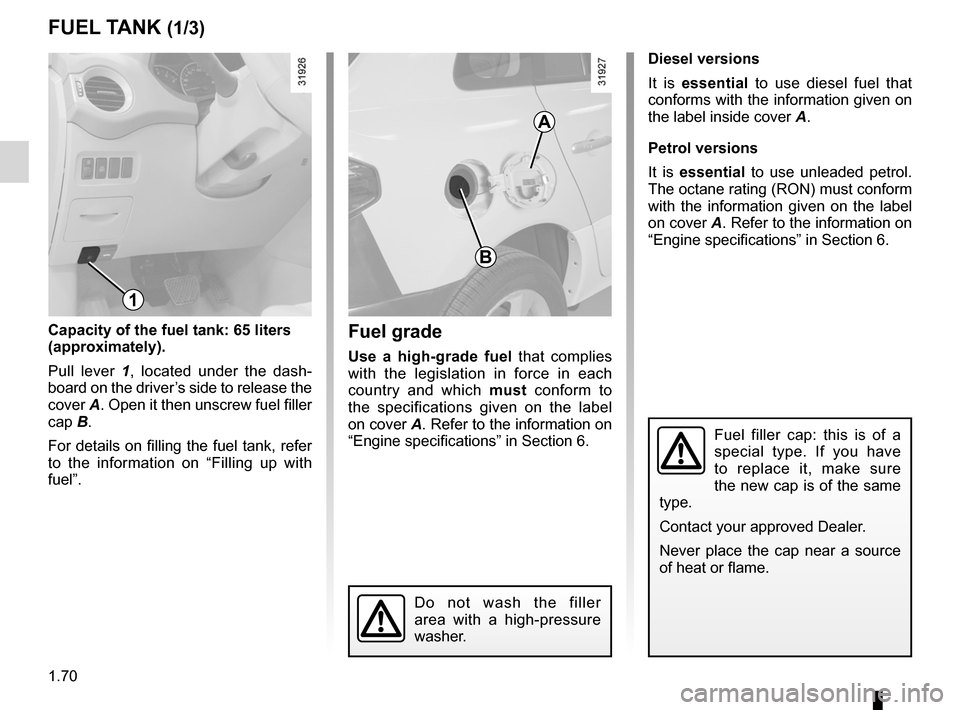
fuel tank capacity .................................. (up to the end of the DU)
fuel capacity ........................................... (up to the end of the DU)
fuel filling ................................................ (up to the end of the DU)
fuel grade ............................................... (up to the end of the DU)
fuel tank capacity ........................................... (up to the end of the DU)
fuel filler cap ......................................... (up to the end of the DU)
1.70
ENG_UD23493_6
Réservoir carburant (X45 - H45 - Renault)
ENG_NU_977-2_H45_Ph2_Renault_1
Jaune NoirNoir texte
Fuel tank
fUEL TANK (1/3)
capacity of the fuel tank: 65 liters
(approximately).
Pull lever 1 , located under the dash -
board on the driver’s side to release the
cover A. Open it then unscrew fuel filler
cap B.
For details on filling the fuel tank, refer
to the information on “Filling up with
fuel”.fuel grade
Use a high-grade fuel that complies
with the legislation in force in each
country and which must conform to
the specifications given on the label
on cover A. Refer to the information on
“Engine specifications” in Section 6.
1
A
B
diesel versions
It is essential to use diesel fuel that
conforms with the information given on
the label inside cover A.
petrol versions
It is essential to use unleaded petrol.
The octane rating (RON) must conform
with the information given on the label
on cover A. Refer to the information on
“Engine specifications” in Section 6.
Do not wash the filler
area with a high-pressure
washer.
Fuel filler cap: this is of a
special type. If you have
to replace it, make sure
the new cap is of the same
type.
Contact your approved Dealer.
Never place the cap near a source
of heat or flame.
Page 77 of 233
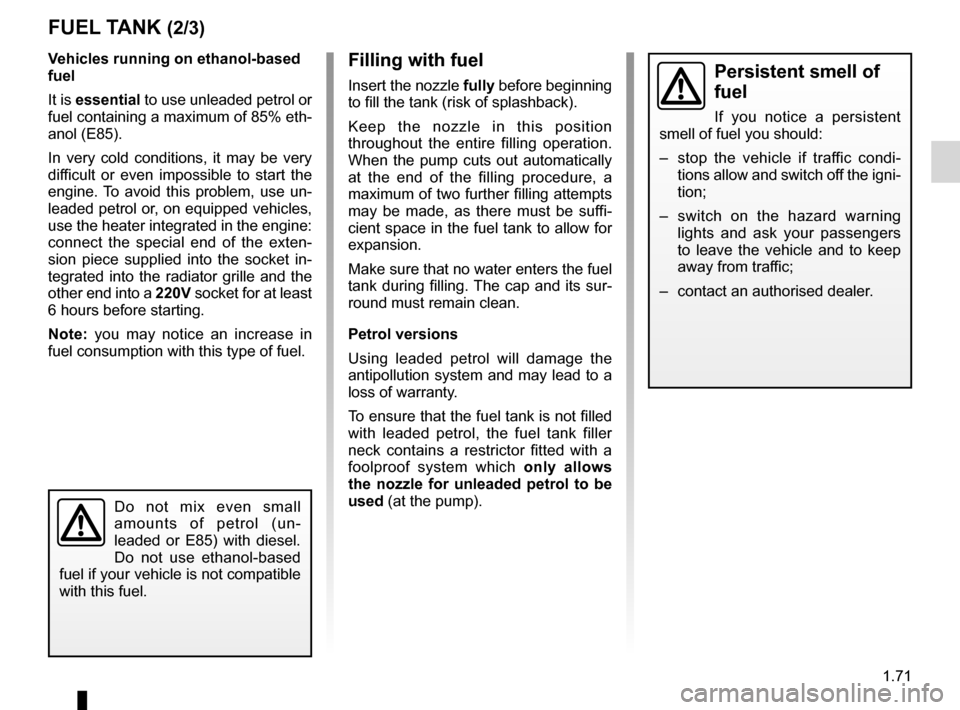
JauneNoirNoir texte
1.71
ENG_UD23493_6
Réservoir carburant (X45 - H45 - Renault)
ENG_NU_977-2_H45_Ph2_Renault_1
v ehicles running on ethanol -based
fuel
It is essential to use unleaded petrol or
fuel containing a maximum of 85% eth-
anol (E85).
In very cold conditions, it may be very
difficult or even impossible to start the
engine. To avoid this problem, use un-
leaded petrol or, on equipped vehicles,
use the heater integrated in the engine:
connect the special end of the exten -
sion piece supplied into the socket in -
tegrated into the radiator grille and the
other end into a 220v socket for at least
6 hours before starting.
Note: you may notice an increase in
fuel consumption with this type of fuel.
Do not mix even small
amounts of petrol (un -
leaded or E85) with diesel.
Do not use ethanol-based
fuel if your vehicle is not compatible
with this fuel.
fUEL TANK (2/3)
filling with fuel
Insert the nozzle fully before beginning
to fill the tank (risk of splashback).
Keep the nozzle in this position
throughout the entire filling operation.
When the pump cuts out automatically
at the end of the filling procedure, a
maximum of two further filling attempts
may be made, as there must be suffi -
cient space in the fuel tank to allow for
expansion.
Make sure that no water enters the fuel
tank during filling. The cap and its sur-
round must remain clean.
petrol versions
Using leaded petrol will damage the
antipollution system and may lead to a
loss of warranty.
To ensure that the fuel tank is not filled
with leaded petrol, the fuel tank filler
neck contains a restrictor fitted with a
foolproof system which only allows
the nozzle for unleaded petrol to be
used (at the pump).persistent smell of
fuel
If you notice a persistent
smell of fuel you should:
– stop the vehicle if traffic condi -
tions allow and switch off the igni -
tion;
– switch on the hazard warning
lights and ask your passengers
to leave the vehicle and to keep
away from traffic;
– contact an authorised dealer.
Page 78 of 233
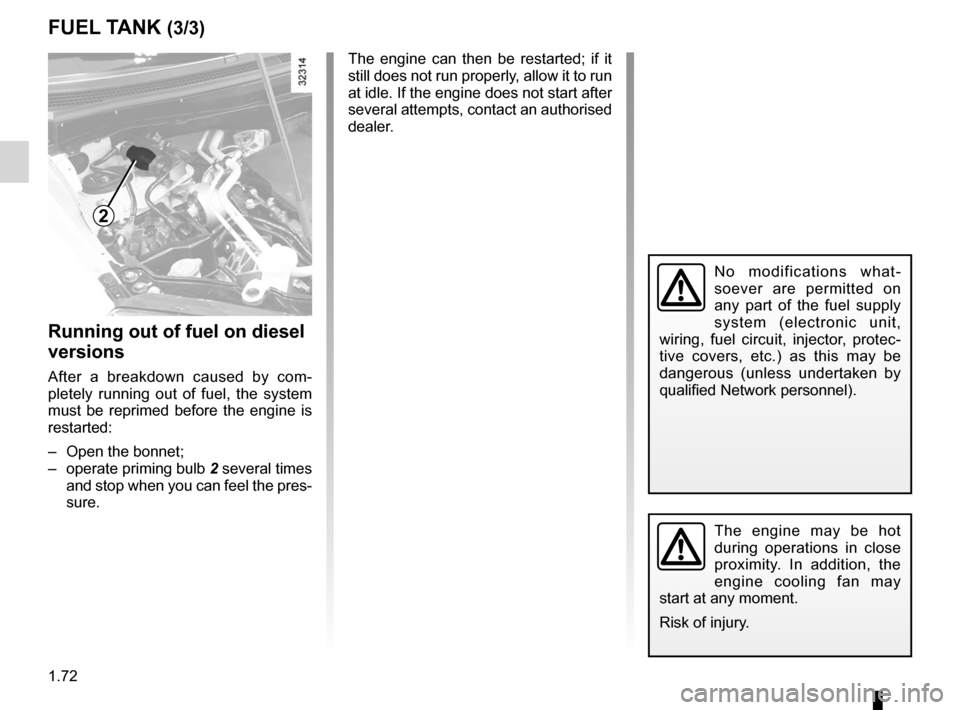
fuel priming bulb ................................... (up to the end of the DU)
fuel repriming ........................................ (up to the end of the DU)
1.72
ENG_UD23493_6
Réservoir carburant (X45 - H45 - Renault)
ENG_NU_977-2_H45_Ph2_Renault_1
The engine can then be restarted; if it
still does not run properly, allow it to run
at idle. If the engine does not start after
several attempts, contact an authorised
dealer.
fUEL TANK (3/3)
2
The engine may be hot
during operations in close
proximity. In addition, the
engine cooling fan may
start at any moment.
Risk of injury.
Running out of fuel on diesel
versions
After a breakdown caused by com -
pletely running out of fuel, the system
must be reprimed before the engine is
restarted:
– Open the bonnet;
– operate priming bulb 2 several times
and stop when you can feel the pres-
sure.
No modifications what -
soever are permitted on
any part of the fuel supply
system (electronic unit,
wiring, fuel circuit, injector, protec -
tive covers, etc.) as this may be
dangerous (unless undertaken by
qualified Network personnel).
Page 79 of 233
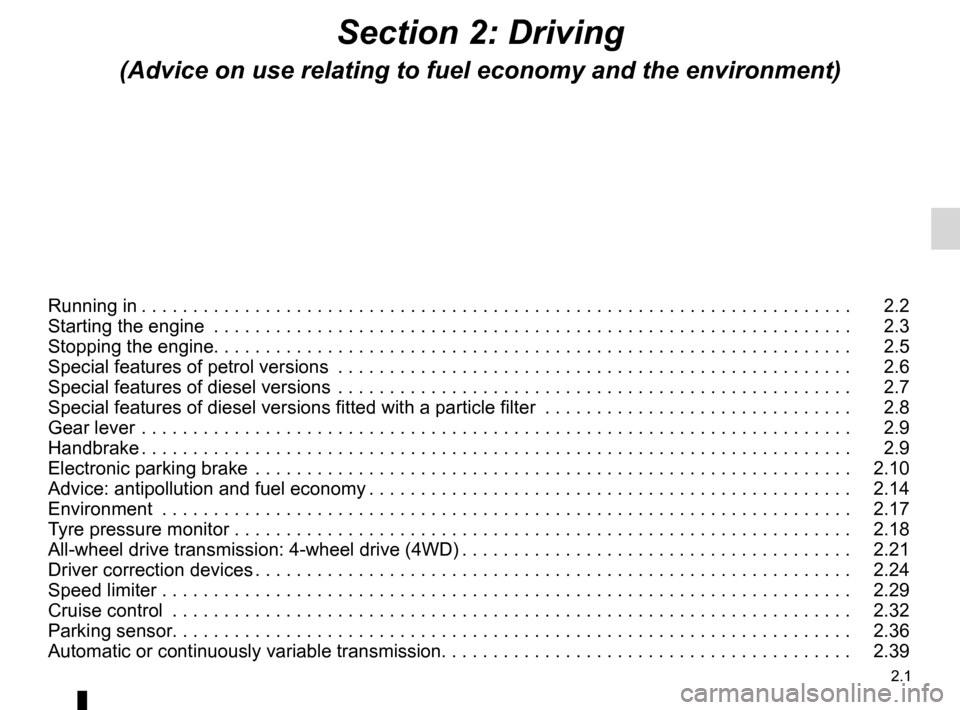
2.1
ENG_UD27164_2
Contents 2 (X45 - H45 - Renault)
ENG_NU_977-2_H45_Ph2_Renault_2
Section 2: Driving
(Advice on use relating to fuel economy and the environment)
Running in . . . . . . . . . . . . . . . . . . . . . . . . . . . . . . . . . . . . . . . . . . . . . . . . . . . . . . . . . . . . . . . . . . . . . 2.2
Starting the engine . . . . . . . . . . . . . . . . . . . . . . . . . . . . . . . . . . . . . . . . . . . . . . . . . . . . . . . . . . . . . . 2.3
Stopping the engine . . . . . . . . . . . . . . . . . . . . . . . . . . . . . . . . . . . . . . . . . . . . . . . . . . . . . . . . . . . . . . 2.5
Special features of petrol versions . . . . . . . . . . . . . . . . . . . . . . . . . . . . . . . . . . . . . . . . . . . . . . . . . . 2.6
Special features of diesel versions . . . . . . . . . . . . . . . . . . . . . . . . . . . . . . . . . . . . . . . . . . . . . . . . . . 2.7
Special features of diesel versions fitted with a particle filter . . . . . . . . . . . . . . . . . . . . . . . . . . . . . . 2.8
Gear lever . . . . . . . . . . . . . . . . . . . . . . . . . . . . . . . . . . . . . . . . . . . . . . . . . . . . . . . . . . . . . . . . . . . . . 2.9
Handbrake . . . . . . . . . . . . . . . . . . . . . . . . . . . . . . . . . . . . . . . . . . . . . . . . . . . . . . . . . . . . . . . . . . . . . 2.9
Electronic parking brake . . . . . . . . . . . . . . . . . . . . . . . . . . . . . . . . . . . . . . . . . . . . . . . . . . . . . . . . . . 2.10
Advice: antipollution and fuel economy . . . . . . . . . . . . . . . . . . . . . . . . . . . . . . . . . . . . . . . . . . . . . . . 2.14
Environment . . . . . . . . . . . . . . . . . . . . . . . . . . . . . . . . . . . . . . . . . . . . . . . . . . . . . . . . . . . . . . . . . . . 2.17
Tyre pressure monitor . . . . . . . . . . . . . . . . . . . . . . . . . . . . . . . . . . . . . . . . . . . . . . . . . . . . . . . . . . . . 2.18
All-wheel drive transmission: 4-wheel drive (4WD) . . . . . . . . . . . . . . . . . . . . . . . . . . . . . . . . . . . . . . 2.21
Driver correction devices . . . . . . . . . . . . . . . . . . . . . . . . . . . . . . . . . . . . . . . . . . . . . . . . . . . . . . . . . . 2.24
Speed limiter . . . . . . . . . . . . . . . . . . . . . . . . . . . . . . . . . . . . . . . . . . . . . . . . . . . . . . . . . . . . . . . . . . . 2.29
Cruise control . . . . . . . . . . . . . . . . . . . . . . . . . . . . . . . . . . . . . . . . . . . . . . . . . . . . . . . . . . . . . . . . . . 2.32
Parking sensor . . . . . . . . . . . . . . . . . . . . . . . . . . . . . . . . . . . . . . . . . . . . . . . . . . . . . . . . . . . . . . . . . . 2.36
Automatic or continuously variable transmission . . . . . . . . . . . . . . . . . . . . . . . . . . . . . . . . . . . . . . . . 2.39
Page 80 of 233
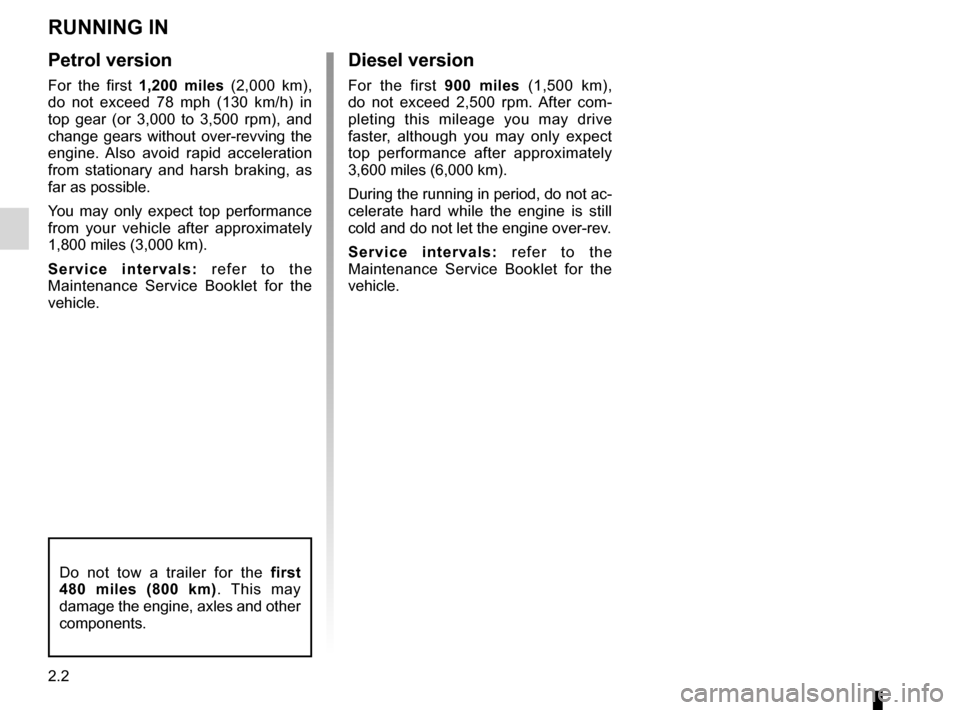
running in .............................................. (up to the end of the DU)
driving ................................................... (up to the end of the DU)
2.2
ENG_UD20969_3
Rodage (X45 - H45 - Renault)
ENG_NU_977-2_H45_Ph2_Renault_2
Running in
RUNNING IN
Petrol version
For the first 1,200 miles (2,000 km),
do not exceed 78 mph (130 km/h) in
top gear (or 3,000 to 3,500 rpm), and
change gears without over-revving the
engine. Also avoid rapid acceleration
from stationary and harsh braking, as
far as possible.
You may only expect top performance
from your vehicle after approximately
1,800 miles (3,000 km).
S e r v i c e i n t e r v a l s : r e f e r t o t h e
Maintenance Service Booklet for the
vehicle.
Diesel version
For the first 900 miles (1,500 km),
do not exceed 2,500 rpm. After com -
pleting this mileage you may drive
faster, although you may only expect
top performance after approximately
3,600 miles (6,000 km).
During the running in period, do not ac-
celerate hard while the engine is still
cold and do not let the engine over-rev.
S e r v i c e i n t e r v a l s : r e f e r t o t h e
Maintenance Service Booklet for the
vehicle.
Do not tow a trailer for the first
480 miles (800 km) . This may
damage the engine, axles and other
components.